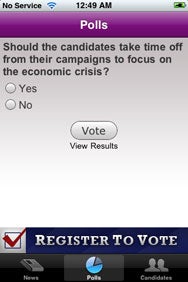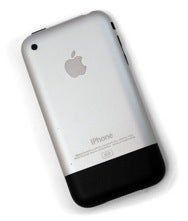Do John McCain voters want one source of news, and Barack Obama voters another? Do undecided voters need different sources of information? Are red state voters and blue state voters so far apart politically that they can no longer share common sources of information?
Let’s hope not. But it seems so. And a new political news application for the iPhone and iPod touch only advances the trend.

Deep Purple: Campaign collects news stories about the election for supporters of John McCain and Barack Obama or, in this case, for undecided voters.
Campaign is a political news aggregator. The developers say the app is designed to “keep our political minds informed” and offers political hobbyists, Beltway insiders, newshounds and “the casual citizen” a way of staying abreast of the 2008 presidential election campaign through a variety of sources. Campaign includes feeds from Reuters, the Associated Press, Politico, Huffington Post, the Chicago Tribune, National Review, Fox News, The New York Times, The New Republic, among others.
Does Campaign work as advertised? Sadly, yes.
When you launch Campaign for the first time, the app prompts you for a political affiliation: Republican, Democrat, or undecided. You can change your political preference in the iPhone or iPod settings. Predictably, the McCain feed (red) relies heavily on Fox News and National Review, while the Obama feed (blue) draws from the Huffington Post and the New York Times. The undecided feed (purple) appears to be the most diverse of the lot, and relies most heavily on old media sources.
Campaign also includes direct links to the McCain and Obama Web sites. There is also a reader poll feature, but the developers appear to have given it little thought. (I had mistakenly assumed the poll button would provide up-to-date tracking poll numbers, much as sites such as
RealClearPolitics,
Politico do, and the
Election ’08 app does. That would have served an actual purpose.)

Poll Dancing: If you tap on Campaign’s poll button expecting the latest poll numbers, you will be sorely disappointed.
Campaign’s news interface—the app’s main attraction—isn’t very good. It groups news by source, rather than chronologically, which is confusing and annoying. What’s more, there is no way to customize the order in which the stories display. And the stories themselves do not always display especially well through Safari. Given the option of reading a New York Times story through Campaign’s portal, or reading the same story through the
Times’ own (free) app, which would you choose?
There should be a way for readers to customize sources, too. It’s stupid and stereotypical to assume, as Campaign does, that Republican readers aren’t interested in news from the Washington Post, the Chicago Tribune or the New York Times. From a purely strategic standpoint, it’s always good to know what your adversaries are up to.
My quarrel with Campaign isn’t with the interface so much as the very premise of the application. The idea that McCain voters have one set of sources, Obama voters have another and never the twain shall meet is an absurdity. America’s unique form of democracy is ill-served by the sort of ideological self-segregation that the Internet has helped foster. An app such as Campaign, however well intended, only reinforces bad habits.
The developers insist they do not to take a side, and claim only “we’re giving you the tools to cast your vote with confidence.” The disclaimer, while appreciated, is utterly futile in the present polarized political climate. Suspicion and ill-will run too high. Good faith is as rare these days as a sold sign on a suburban McMansion.
Partisans, you can be certain, will find plenty to complain about Campaign. McCain’s site loads slower than Obama’s site? Campaign is obviously in the tank for Obama. The aggregator feeds too much Fox News content? Campaign is a wholly owned subsidiary of the McCain machine. The undecided feed relies too much on liberal sources? Campaign is a subtle propaganda tool for the Democrats. (In fact, the undecided feed does lean heavily on The Atlantic, The New Republic and The New York Times. A little more balance there wouldn’t hurt.)
Despite the app’s quirks—and, yes, its biases—Campaign is just barely worth the dollar. Political news junkies need their regular fixes, and Campaign delivers, roughly as promised. With about 40 days before the November general election, it’s hardly likely that Campaign will improve any more than the actual campaigns will. That said, I look forward to seeing the 2012 version. Assuming the Republic endures that long.


 Deep Purple: Campaign collects news stories about the election for supporters of John McCain and Barack Obama or, in this case, for undecided voters.
Deep Purple: Campaign collects news stories about the election for supporters of John McCain and Barack Obama or, in this case, for undecided voters. Poll Dancing: If you tap on Campaign’s poll button expecting the latest poll numbers, you will be sorely disappointed.
Poll Dancing: If you tap on Campaign’s poll button expecting the latest poll numbers, you will be sorely disappointed.